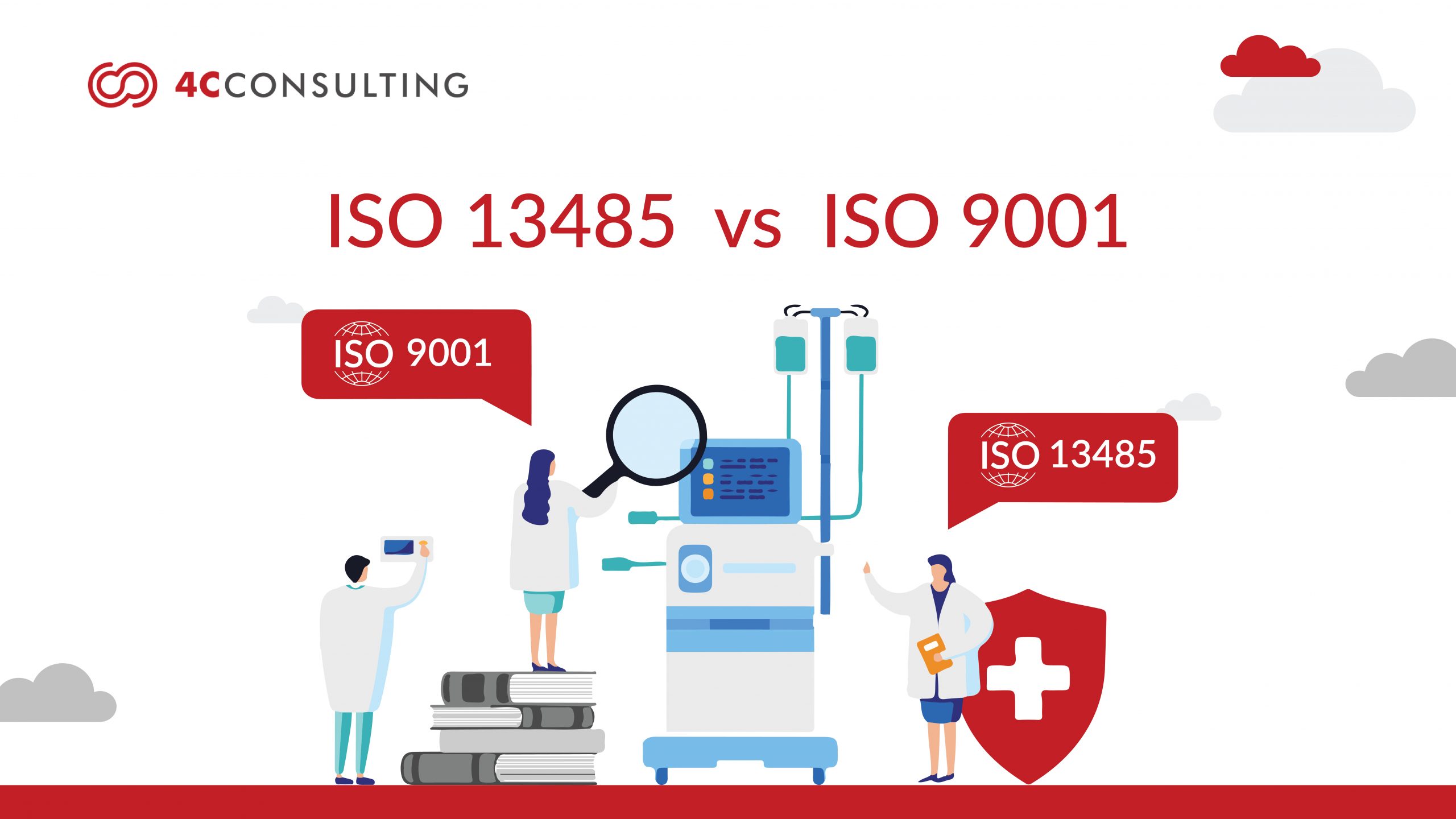
ISO 13485 Vs ISO 9001: Key Differences in Medical Device and Quality Standards
17th May, 2024
In today’s rigorous and regulation-driven market, particularly within the medical device sector, understanding and navigating the distinctions between ISO 13485 and ISO 9001 standards is pivotal. While ISO 13485:2016 is crafted specifically to support medical device manufacturers in meeting comprehensive regulatory requirements, ISO 9001:2015 spans various industries, focusing on general quality management to enhance customer satisfaction and operational efficiency. This analysis will delve into the specific requirements, similarities, and critical differences between these standards, providing businesses with the insights needed to optimize their quality management systems. By exploring these standards in depth, organizations can better prepare themselves for market challenges, ensuring compliance and excellence in their operational processes.
.
What is ISO 13485: 2016?
ISO 13485 is designed specifically for the medical device industry, focusing on the safety and quality of medical devices throughout their lifecycle. As a globally recognized standard, it outlines requirements for a comprehensive quality management system (QMS) that assists manufacturers in meeting both customer and regulatory demands. The primary aim of ISO 13485 is to facilitate consistent design, development, production, installation, and delivery of medical devices that are safe for their intended purposes.
.
Benefits of ISO 13485
- Improved Device Quality: ISO 13485 ensures consistent compliance with both customer and regulatory requirements, critical for maintaining the safety and effectiveness of medical devices.
- International Acceptance: Achieving ISO 13485 certification is recognized globally, facilitating market entry and expansion for companies internationally.
- Enhanced Risk Management: The standard prioritizes risk management throughout the product lifecycle, enhancing safety and quality from design through to after-sales support.
- Increased Operational Efficiency: Implementing the standardized processes of ISO 13485 can lead to streamlined operations, minimizing waste and boosting production efficiency.
- Market Differentiation: Obtaining ISO 13485 certification showcases a company’s dedication to quality, providing a competitive edge in the crowded medical device market and fostering greater customer trust.
.
What is ISO 9001:2015?
ISO 9001 is a universal standard that specifies requirements for a quality management system (QMS). It is applicable to organizations in all types of industries and is designed to help companies ensure that they meet the needs of customers and other stakeholders while also meeting statutory and regulatory requirements related to a product or service. ISO 9001 is based on the principle of continual improvement and emphasizes customer satisfaction as a central goal. The primary purpose of ISO 9001 is to provide a practical and workable Quality Management System for improving and monitoring all areas of your business.
.
Major Benefits of ISO 9001
- Increased Efficiency: Companies that go through the ISO 9001 certification process have gained a more efficient and effective operation, streamlined by the adoption of clear processes and a focus on quality.
- Higher Degree of Customer Satisfaction: By understanding customers’ needs and reducing errors, companies can enhance customer satisfaction. ISO 9001 is designed to prioritize meeting customer requirements and enhancing their satisfaction.
- Improved Employee Engagement: Employees understand the workflow better, which can lead to increased job satisfaction, improved morale, and motivation through improved training capabilities.
- Global Recognition: ISO 9001 is globally recognized as the benchmark for quality in the workplace, integrating seamlessly with other international standards, making it easier for organizations to enter new markets.
- Facilitates Continuous Improvement: ISO 9001 encourages a continual improvement process within organizations, helping them to streamline operations and optimize operations, which can lead to cost savings.
.
Difference Between ISO 13485 vs. ISO 9001
Understanding the specific differences between ISO 13485 and ISO 9001 is essential for organizations looking to implement standards tailored to their operational and regulatory needs. The major difference between both the standards is –
1. Scope and Application
- ISO 13485: Tailored specifically for organizations involved in the design, production, installation, and servicing of medical devices. This standard focuses on ensuring medical devices meet rigorous regulatory safety and quality requirements.
- ISO 9001: Intended for use by any organization in any industry or sector. It provides a framework for achieving excellence and customer satisfaction across all business processes, regardless of the product or service provided.
.
2. Objective
- ISO 13485: Ensures the consistent design, development, and production of medical devices that are safe for human use. The standard also extends to cover the responsiveness of post-market surveillance systems to protect public health.
- ISO 9001: Seeks to make a culture of continuous improvement and client focus across an organization. It encourages companies to streamline their processes and enhance efficiency, thus potentially reducing overhead costs and increasing profitability.
.
3. Design and Development Controls
- ISO 13485: Imposes stringent controls on the design and development processes of medical devices. This includes detailed requirements for planning, input and output specifications, design reviews, verification, validation, and design transfer to ensure the device meets all safety and performance criteria.
- ISO 9001: Encourages organizations to implement effective design and development controls but allows greater flexibility. It focuses on ensuring that products and services meet customer requirements and emphasizes continuous improvement without prescribing specific processes.
.
4. Risk Management Emphasis
- ISO 13485: Mandates a risk management approach throughout the entire product lifecycle, ensuring that all possible hazards related to medical devices are identified, evaluated, and controlled. This ongoing process supports the need for continual reassessment and updates to safety measures.
- ISO 9001: Focuses on risk as part of decision-making processes. It prompts organizations to identify opportunities that mitigate risk and enhance business outcomes, which can lead to innovative solutions and market leadership.
.
5. Change Management
- ISO 13485: Requires a formal change management process to control changes that could impact product quality or compliance with regulatory requirements. This includes assessing the impact of changes, documenting them, and obtaining necessary approvals.
- ISO 9001: Encourages organizations to control changes to processes, products, or services to ensure continued conformity with requirements. It focuses on the overall impact on the quality management system and customer satisfaction.
.
6. Calibration and Maintenance of Equipment
- ISO 13485: Requires regular calibration and maintenance of equipment used in the production and testing of medical devices to ensure accuracy and reliability. This includes maintaining records of calibration and maintenance activities.
- ISO 9001: Also requires calibration and maintenance of equipment but allows more flexibility. The emphasis is on ensuring that equipment is capable of producing accurate and reliable results, supporting overall product quality.
.
7. Documentation Specificity
- ISO 13485: Expects organizations to maintain a documented system that explicitly demonstrates each process’s compliance with the required standards. This level of documentation is often essential for supporting new product approvals or registrations from regulatory bodies.
- ISO 9001: Encourages organizations to document their systems to the extent necessary to demonstrate planning, operation, and control of processes. It emphasizes the importance of maintaining records to evidence the quality system’s effectiveness but does not prescribe the extent or format of documentation, allowing for more customization.
.
8. Product Traceability
- ISO 13485: Requires that all devices be traceable down to the batch, lot, or unit, facilitating effective recall procedures and precise monitoring of product issues to ensure patient safety.
- ISO 9001: While traceability can be a component of an ISO 9001 compliant system, it is not inherently required. Companies may implement traceability in instances where it supports the quality management aims or customer requirements.
.
9. Regulatory Compliance
- ISO 13485: Strongly tied to compliance with specific international and national regulatory requirements, which are often a legal necessity for placing medical devices on the market. It includes provisions for meeting these regulations, which are critical for product approval and ongoing market access.
- ISO 9001: While it encourages compliance with statutory and regulatory requirements, it primarily guides on the overall management system. It allows organizations to adapt the standard to their specific needs, including regulatory compliance, if applicable.
.
Understanding the distinctions between ISO 13485:2016 and ISO 9001:2015 is crucial for organizations that aim to enhance their quality management systems. ISO 13485:2016 is specifically designed for the medical device sector, focusing on ensuring product safety and compliance with rigorous regulatory standards, which is essential for manufacturers to access global markets and ensure patient safety. In contrast, ISO 9001:2015 offers a broader framework applicable to any industry, aimed at improving overall operational efficiency and customer satisfaction. By selecting the appropriate standard, organizations can align their operational goals with industry-specific requirements, enabling them to navigate market challenges effectively and secure long-term success.
.
How We Can Help You Make the Right Choice
At 4C Consulting, we guide you in choosing between ISO 13485 and ISO 9001, ensuring your organization’s quality management system meets your specific needs and regulatory requirements. Our team of experienced consultants, with over 15+ years of expertise and 5000+ hours of training, offers tailored support for both standards. For ISO 13485, we help medical device companies comply with stringent regulatory requirements, focusing on patient safety and product quality. For ISO 9001, we assist organizations across various industries in streamlining processes, improving efficiency, and achieving customer satisfaction. With a proven track record and a commitment to customized solutions, we provide comprehensive support from initial gap analysis to final certification. Contact us now to learn more.
